Amir Chakhmaq Complex
The Amir Chakhmaq Complex in Yazd is a captivating ensemble featuring a square, tekyeh (a place for religious mourning ceremonies), bazaar, reservoir, and mosque.
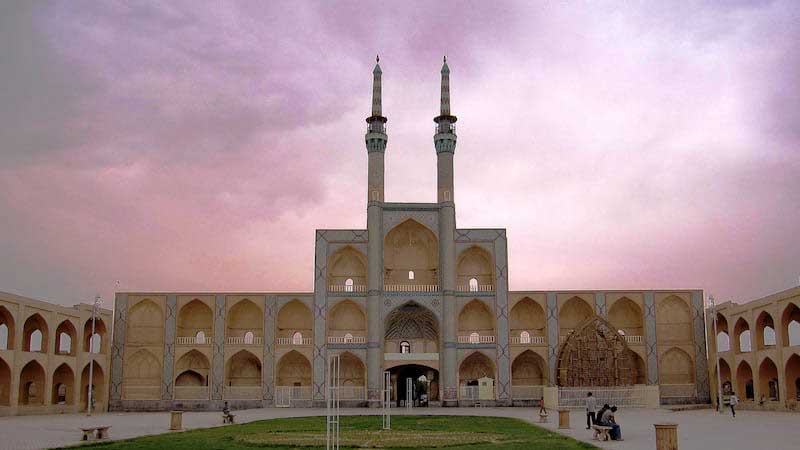
Amir Chakhmaq Complex in Yazd
This historical site traces its origins back to the Timurid period, dating to the 9th century. It was commissioned by Jalaluddin Amir Chakhmaq, the ruler of the city during that era. In 1330, Amir Chakhmaq’s book was officially registered as part of this collection. To visit the Amir Chakhmaq Complex, head to Imam Street, Amir Chakhmaq Square.
Yazd Grand Mosque
The Yazd Jame Mosque stands as a unique architectural marvel, nationally registered in 1313. This grand structure graces the west side of Imam Khomeini Street within one of Yazd’s historic neighborhoods.
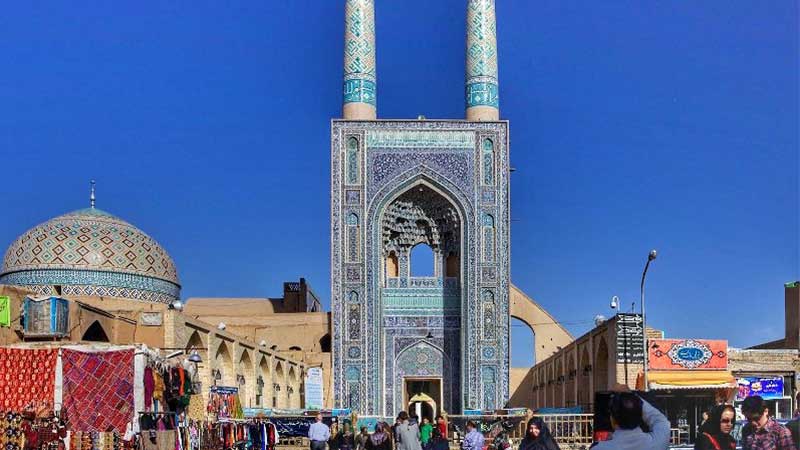
Yazd Grand Mosque (Jame Mosque)
The Jame Mosque of Yazd boasts a raised porch, two additional balconies, two shelter houses, a dome, two qanat entries, and a spacious rectangular courtyard. Notably, the mosque features six entrances, each situated in different sections of the mosque.
Zein-o-Din Caravanserai
Zeinoddin Caravanserai in Yazd boasts a rich history, dating back 400 years, constructed by the order of Shah Abbas. This two-story caravanserai primarily employs clay bricks as its construction material.
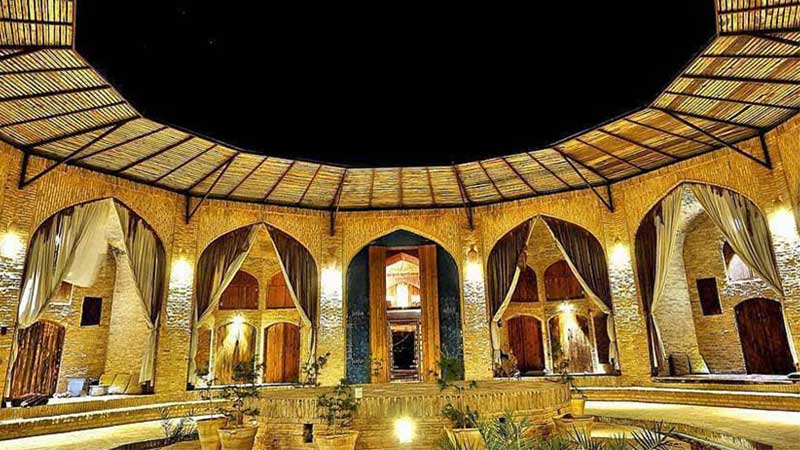
Zein-o-Din Caravanserai
Situated 60 kilometers from the Yazd-Kerman Road, Zainuddin Caravanserai received recognition from UNESCO in 2006, earning the distinction of the best-restored building.
The Icehouse of Meybod
Located approximately 50 kilometers north of Yazd, the Meybod clay Icehouse served as an ancient facility for ice production. Inside these icehouses, you’ll typically find three main components: the shading wall, the ice production basin, and the ice tank.
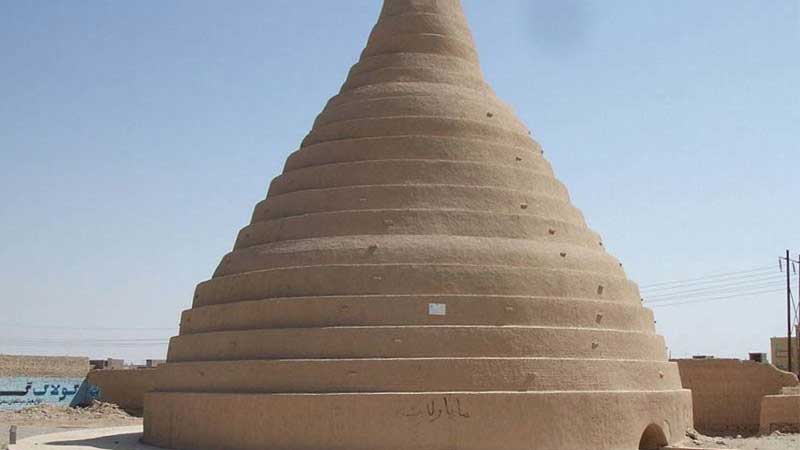
The Icehouse of Meybod
The use of clay and mud in construction ensures efficient insulation, preventing heat from entering and cold from escaping. The Meybod clay Icehouse dates back to the pre-Qajar era, possibly from the Safavid period, and is the largest of its kind.
Lari House
The Lari House in Yazd is a historical structure dating back to the Qajar period, constructed approximately 150 years ago by its owner, Haj Mohammad Ebrahim Lari. This mansion consists of six houses, designed in the architectural style of desert homes, and previously functioned as a Nematullahi monastery.
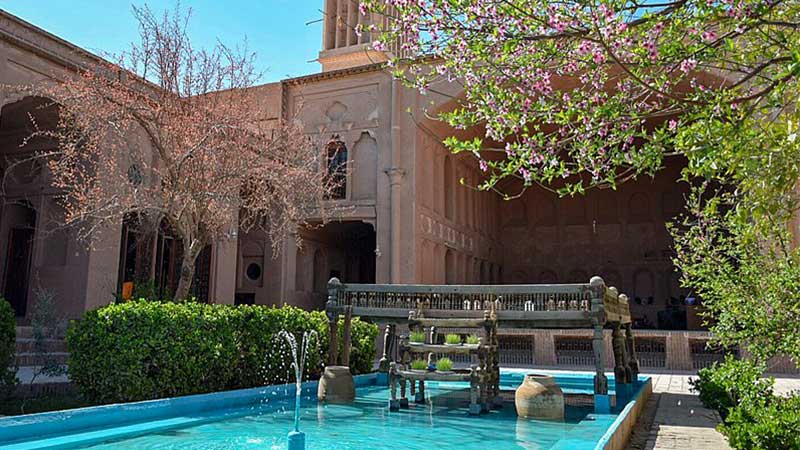
Lari House in Yazd
In February 2015, Lari’s House received national recognition. To reach the Yazd Lari House, head to Imam Khomeini Street in the Fahadan neighborhood, situated near the Kolah Farangi mansion.
Hasht Bagh-e Daulatabad (Eight Gardens)
The Daulatabad Garden, located in Shahid Rajaei Street in the heart of Yazd, ranks among Iran’s most beautiful gardens. Upon entering the garden, visitors are greeted by a relatively spacious vestibule where Yazd’s handicrafts are available for purchase. This garden’s construction dates back to the Afshariya and Zandiye eras. It features lush green spaces, fruit trees, and enchanting flowers, creating a truly unique ambiance. The Daulatabad Garden encompasses the Sardar mansion, vestibule, Badgir building, Behesht Ayin mansion, Hall of Mirrors, Tehrani mansion, reservoir, and Nasser Garden. Notably, it boasts a towering windcatcher, considered the world’s tallest of its kind.
Yazd Mirror and Lighting Museum
Yazd Museum of Mirrors and Lighting holds the distinction of being Iran’s only specialized museum dedicated to light. Established in the Sarafzadeh House in 1377 (solar year), the museum showcases a diverse array of lighting devices, including tallow burners, candle burners, oil lamps, and electrical fixtures, crafted from materials such as pottery, glass, brass, copper, and bronze. The museum building, known as Kushki, is nestled within a garden and was constructed during the First Pahlavi era. You can find this museum on Kashani Street, facing Haft-e Tir Park in Yazd.
The Traditional Hammam-e Khan (Khan Bath)
Built in 1212 AH, Khan Bath, during the Qajar era, originally served as a public bathhouse and was affectionately known as “Khan’s Bath” due to its popularity among the city’s upper class. In the past, it functioned not only as a place for bathing but also as a social hub for conversations, relaxation, gathering with friends, and discussions of life matters. Today, it has been revitalized into a traditional restaurant and teahouse, attracting numerous tourists.
Tower of Silence
Located 15 kilometers southeast of Yazd, the Silent Tower served as a Zoroastrian crypt or tower of silence. According to Zoroastrian tradition, the deceased were placed in these crypts to be exposed to vultures.
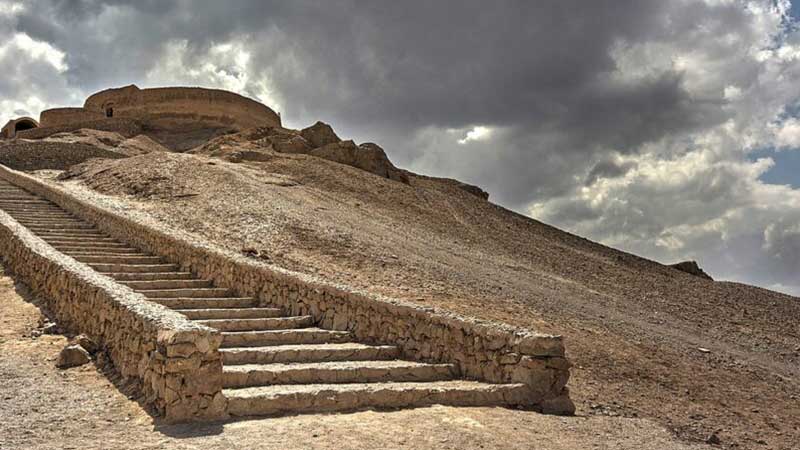
Tower of Silence in Yazd
The bones left behind after the scavenging were deposited within the tower. This tower stands atop a mountain in the Safaiye area of Yazd, preserving a unique aspect of Zoroastrian culture.
Kharanagh Village in Yazd
Situated 85 kilometers from Yazd, Kharanagh Village boasts over a thousand years of history. Within the village, an ancient castle was inhabited until just two decades ago. The village also features a 17th-century minaret and a caravanserai, which have been restored and offer affordable accommodations for visitors.
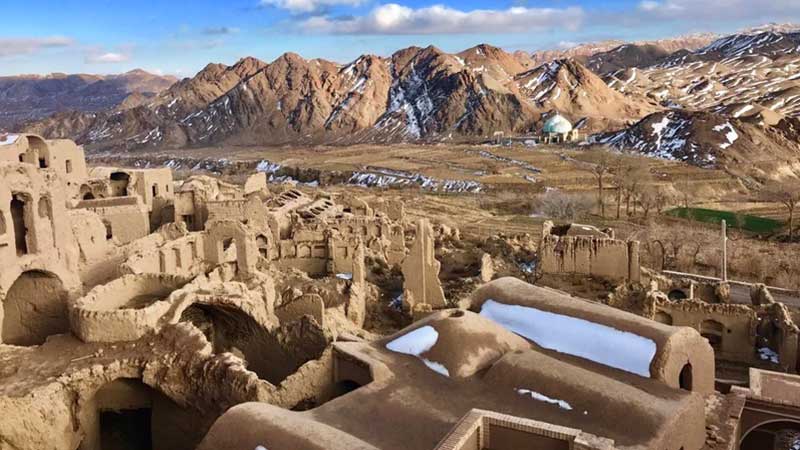
Kharanagh Village
Ab Anbare 6 Badgir
Ab Anbare 6 Badgir or The Six Windcatcher Water Reservoir, a structure with a heritage spanning 180 years, stands as a testament to the Qajar era.
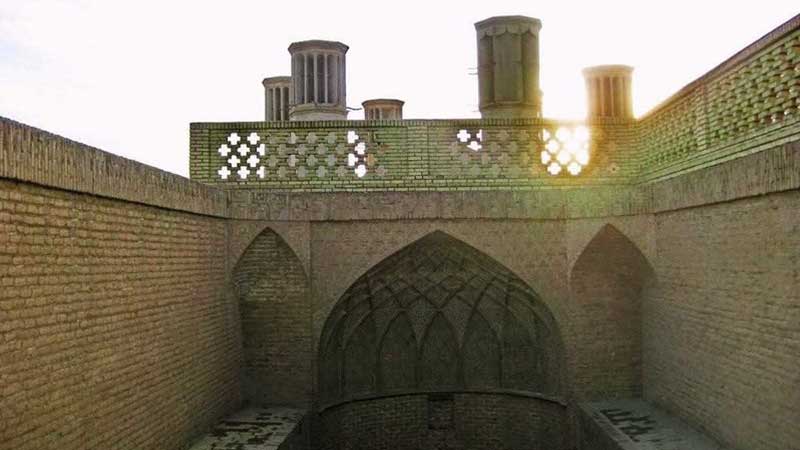
The Six Windcatcher Water Reservoir
This reservoir, located in Shahid Beheshti Square on 10th Farvardin Street, includes six windcatcher towers—three of them are original, while the other three are newer additions.
Ab Anbare Giv
Built in 1320, the Giv Yazd Water Reservoir has played a vital role in supplying water to the local populace. As its name suggests, this reservoir served as a water storage facility, a crucial feature, especially in arid regions like Yazd.
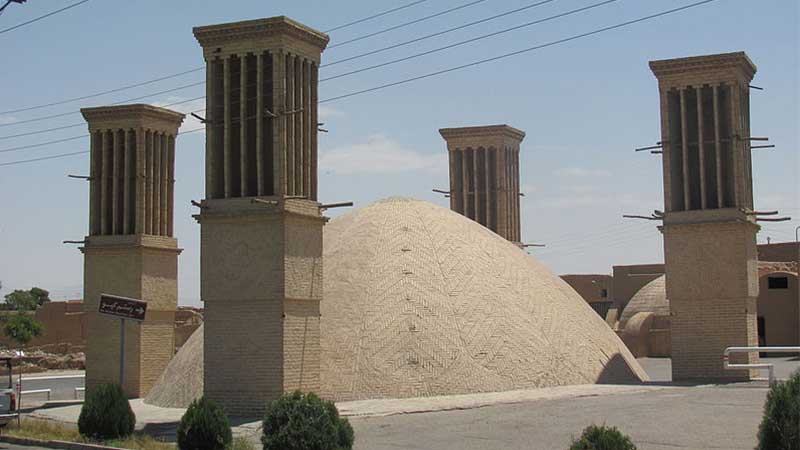
Giv Water Reservoir
Constructed during the Qajar era, the Giv Reservoir was nationally recognized in 1375 and can be found in the Zartoshtian neighborhood, around Basij Boulevard.
Ashkezar Water Mill in Yazd
The Ashkezar Water Mill, one of Iran’s largest mills, was constructed during the Safavid era and utilized the power of the Hematabad qanat to grind wheat and other grains into flour. The mill’s interior showcases intricate brickwork, geometric patterns adorning the walls, and a well-preserved courtyard, all exhibiting exceptional craftsmanship. What makes the Ashkezar Mill truly exceptional is its underground construction, a rarity worldwide.
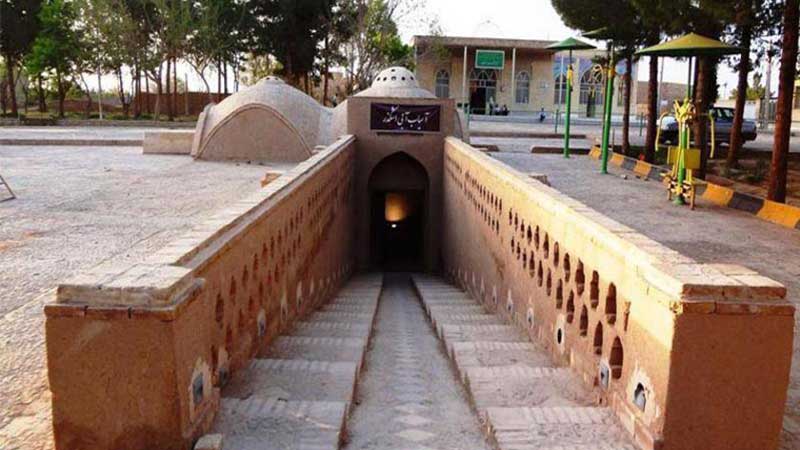
Ashkezar Water Mill
The mill is supplied with water through underground aqueducts, further adding to its uniqueness. Access to the mill is through an arched brick gate on the surface, leading to a complex located seven meters below ground level. Situated on the western edge of the Yazd desert, the Ashkezar Mill, located on the main road of Rastaq, connecting Ashkezar to Bandar Abad, has earned a place on the list of Iran’s national heritage.
The Great Dome of Abarkuh
The Abarkuh High Dome, also known as the Ali Dome, stands as a relic from the Seljuk period. Presently, it is considered one of the healthiest buildings from that era. This dome, crafted from stone and mortar, serves as the final resting place of Amir Shams ad-Dowleh ibn Ali Hezarasb, a daylamite ruler. The dome was erected by order of his son.
Scillating minaret of Kharanaq
If you’re seeking the world’s sole all-clay minaret, you’ve arrived at the right destination. Oscillating minaret of Kharanaq, entirely crafted from clay, ranks among the world’s most remarkable minarets. This extraordinary architectural wonder traces its origins to the Sasanian period, predating the renowned Menar Jonban in Isfahan. The minaret of Kharanaq stands at a height of three floors and is located on the northern side of the Kharanaq Mosque. It precedes the mosque in age, and it’s worth noting that the minaret’s swaying motion can be clearly observed. You can find the Oscillating minaret of Kharanaq 65 kilometers from Ardakan, along the route to Tariq al-Reza.
Tomb of Seyyed Ruknuddin
The mausoleum of Seyyed Rukn al-Din, once known as the Rukniyeh School, forms a part of a vast historical complex that encompassed a school, observatory, library, mosque, apothecary, hospital, and monastery.
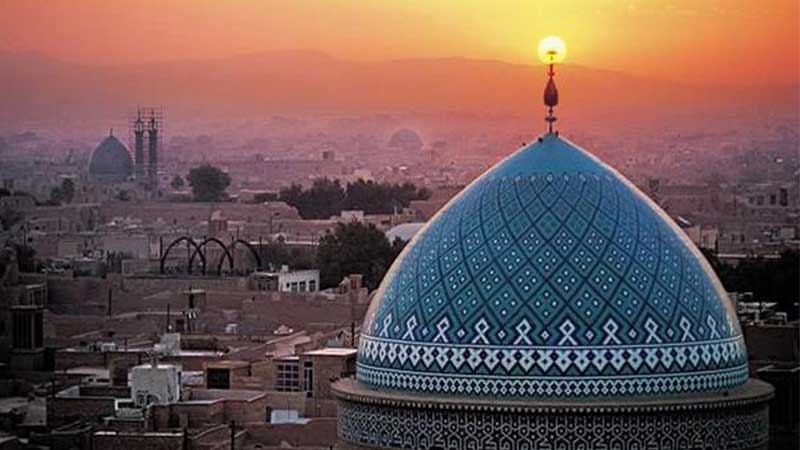
Tomb of Seyyed Ruknuddin
The construction of this historical complex is believed to have concluded in the year 527 AH. Over the centuries, it has undergone transformations and stands today as the Seyyed Ruknuddin Mausoleum. Situated on Jame Kabir Mosque Street in Seyyed Ruknuddin Alley, this tomb received national recognition in December 1935.
Tomb of Seyyed Shamsuddin
The Tomb of Seyyed Shamsuddin, located in the Chahar Minar neighborhood of Yazd, is a remaining complex. Seyyed Shamsuddin, the son of Seyyed Ruknuddin, founded this site.
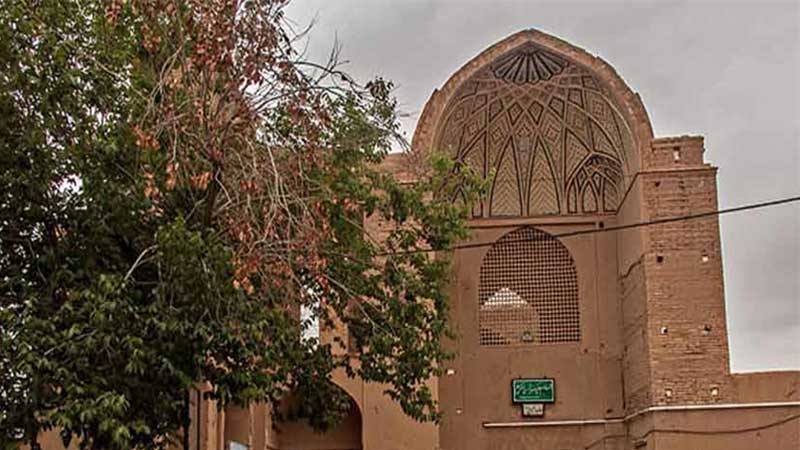
Tomb of Seyyed Shamsuddin
Renowned for its decorative elements, the Seyyed Shams al-Din Tomb showcases intricate features such as inscriptions, mosaic tiles, intricate designs, floral patterns, sun motifs, and bergamot designs. These architectural details have endured the test of time.
Iskandar Prison (Ziaiyeh School) in Yazd
Iskandar Prison, also known as Ziaiyeh School, is an ancient educational institution with a history dating back eight centuries. Established by Ziauddin Hussain Razi in 631 A.H., the school was completed by his sons in 705 A.H. Within the school’s courtyard, you’ll find a notable well with a two-meter diameter, leading to a five-meter-deep cellar. Although many of its decorations have been lost, the dome of this building still stands at an impressive height of 18 meters. It is believed by some to have historical ties to Alexander the Great’s conquests, initially serving as a prison before changing its purpose. Ziaiyeh School is situated in the Fahadan neighborhood of Yazd, and was officially registered in March 1968.
Sarv-e Abarkuh (Abarkuh Cedar)
The Abarkuh Cedar, located in the city of Abarkuh, stands as one of the world’s oldest living entities. The circumference of its trunk on the ground measures 11.5 meters, with a towering height of 25 to 28 meters. According to Russian scientist Alexandrov, this cedar is over 4,000 years old.
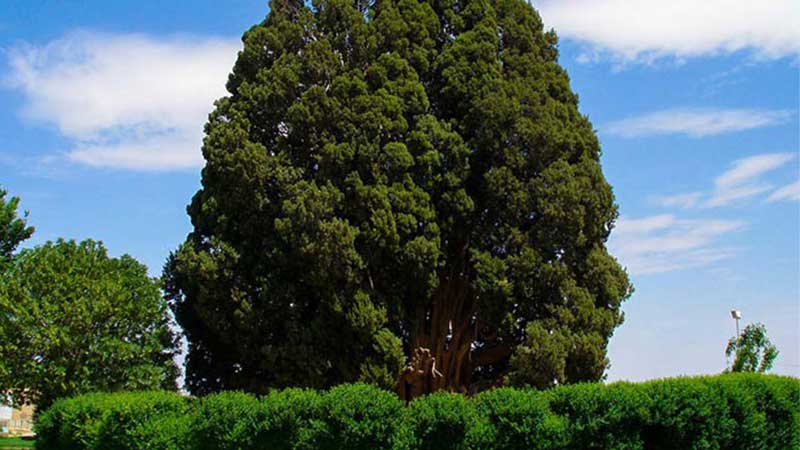
Sarv-e Abarkuh
Hamdullah Mostofi, in his book “Nezhat al-Qulob,” wrote about Abarkuh Cedar, acknowledging its global renown and mythical origins, with legends attributing its planting to Zoroaster or Noah’s son. This ancient cedar is recognized as one of Iran’s national natural monuments.
Zarch Qanat in Yazd
The Zarch Qanat, situated in Yazd province, boasts the distinction of being the world’s longest aqueduct, spanning 100 kilometers. Originating in the village of Fahraj, it traverses multiple villages and neighborhoods within Yazd city before reaching its destination in Zarch.

Zarch Qanat
After the introduction of Islam to Iran, a historical mosque was constructed in Yazd city, nestled within the sacred area of this qanat. The mosque served a dual purpose, enabling the filling of the reservoir beneath it and providing worshippers with a location for ablution (a ceremonial act of washing parts of the body). Notably, the wells in the Zarch Aqueduct are square in shape, a unique feature compared to elliptical or circular wells found in other qanats. The history of these wells can be traced back to Zoroastrian times. The Zarch Aqueduct was nationally registered in July 2004.
Frequently Asked Questions
What are the nicknames of the city of Yazd?
Yazd is known as “City of Winds”, “Desert Bride”, “Dar Al-elm (the place of science)” and “City of Bicycles”.
In which period was the Amir Chakhmaq complex built?
This collection dates back to the Timurid period (ninth century).
Which historical building in Yazd won the award for the best restored building?
In 2006, the UNESCO organization awarded the prize for the best restored building to Zainuddin Caravanserai.



